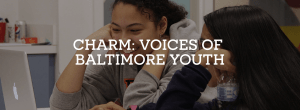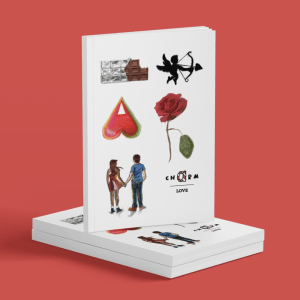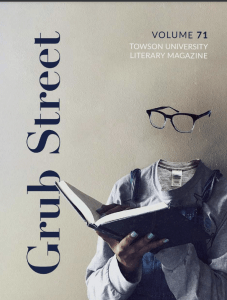This interview was conducted by Madisyn Parisi and has been edited for clarity and length.
CHARM Lit Mag is a project of CHARM: Voices of Baltimore Youth, a literary arts organization founded on the idea, according to the organization, that “kids’ voices matter.” The journal’s mission is “to help young people develop as writers and create opportunities to amplify their voices through publication.”
The organization recently moved into a new work space in Baltimore.

MP: You’re one of CHARM’s cofounders. Can you tell me how this all started, where this idea came from, and how you went about it?
WWB: I was a middle school teacher for 13 years in Baltimore City schools, and around 2013, a group of teachers around the city, along with our students, got together and wanted to have this one-time, city-wide literary magazine that kids could submit to. We hoped it would grow, but we didn’t have intentions of that at that time, so in 2014, we published our first magazine. It had 44 pieces of writing and art from six schools. We had this great publication party, and we were just like, “Huh, this is really amazing.” So over time we started to publish a yearly anthology and also started to offer workshops for students in Baltimore. In 2018, I decided to make the leap into doing this for my full-time job. It’s just been such a joy. We still do that yearly anthology–that’s the core of what we do. We still have a student editorial board who produces all our publications, but we’re also growing our programming. It’s really in service of the mission: supporting young writers and amplifying their voices.
MP: So it’s been ten years? Wow. You were all hoping CHARM would grow, but was there anything that caught you off guard in this process?
WWB: Well, one thing is that we live in such a digital world, but the power of young people seeing CHARM in print and how transformative that can be. I remember the first year, talking to my own middle school students and saying, “You should submit your own writing. This is a really cool opportunity!” and they were like, “Yeah, yeah, yeah… ” and then the day that I brought the publication in, they were all like, “Why didn’t you tell us about this? This is so cool!” Seeing your own writing in print is just so empowering, and I love that. That’s still very much a core piece of who we are. Part of the lesson [we’ve learned] is that a lot of people don’t just submit on their own. It takes this personal relationship building of “I know this really great writer. I’m going to invite them. I’m going to encourage them to submit.”
MP: You mentioned the student editorial board. How student-run is all of this? How hands-on are you as a director? Are there times when you really step in?
WWB: I think I fall back on my experience as a teacher: How much of this is guided practice? How much of this is instructing by doing versus just letting students have at it, conceptualize, and create? We tend to fall more on the side of guided the first semester, and the second-semester students have a little more free rein. Part of that just works out nicely with the way the school year falls. We do a smaller project in the fall, then the annual anthology in the spring. But we also have students who have been with us for a long time, and that’s really nice because they take the lead. We have a student right now who is a senior at Baltimore City College (a high school), and she’s our publications team leader. She really leads and prepares the meetings, and sometimes I chime in, but once a student has been with CHARM for a couple years, they really know all there is to know about helping bring the publication to life.

MP: Do you and the students see any trends in the submissions to the anthologies lately? I saw “This is Not a Snow Day,” which documented quarantine life, on the site, and I thought that was interesting.
WWB: That actually morphed into our first hardcover book. So we came out with a book called Unmasked, and the students coordinated that throughout the seasons of Covid. Spring 2020, Spring 2021. It’s such a great documentation of not only living through that time period, but being a young person during that time period. The summer of 2020 is filled with lots focused around Black Lives Matter and things motivated by the George Floyd killing and protests happening around the country, so you can really feel the progression of that year. Back to your question, we have noticed a lot of writing that deals with the current world and what it’s like to live in this time. Two years ago, there were definitely some students who were like, “We really want to make sure we’re focusing on joy and fun because everything is so heavy. We want to counteract that. It doesn’t all have to be Covid and negativity.” And those particular students felt strongly that it was important to also be highlighting joy, and I think that’s important.
MP: Speaking of the political times we’re in, where do you see CHARM Lit Mag fitting in as a Baltimore publication? Grub Street’s also a Baltimore publication, so we know people always have a lot to say about Baltimore. I think a few years ago [Baltimore] got called rodent-infested. So where do you see CHARM Lit Mag in that Baltimore identity?
WWB: So, I’m from North Carolina, and I’ve been here now for almost 20 years, since 2005, and I think there’s something about Baltimore that people who live here are very fiercely protective of the city and its reputation. That idea that there is this narrative of Baltimore that isn’t true needs to be subverted, and the people who live here really know all the amazing and incredible things that are happening here. And I feel that very much with our students. I don’t know if there are other cities or towns where people feel that way. I think it’s kind of a unique thing for Baltimore. A lot of the work we publish is–whether intentionally or just sort of imbued with things about Baltimore–about the city and its challenges but also its beauty. That’s in its writing.
One other thought I have about that is that during the pandemic, some of our students wanted to create a journalism arm of CHARM. So we actually have, in addition to our literary publications, The Charm Report. We have some local journalists who support our students learning about reporting. That’s newer, but it follows that model of instruction and supporting them as learning to become reporters, but also having the students really own [it]. What are the topics that you care about, what do you want to write about, what story needs to be told?
MP: Going off of that, are there any upcoming opportunities at CHARM you want to talk about?
WWB: Yes! So we have an open call for submissions for students K-12 about chaos. That closes in March and will be out this spring. We are gearing up for our summer publishing internship which will place 20 teenagers at local publishing and media sites all around Baltimore. Last year, we had students at The Baltimore Banner and The Afro, several local bookstores, and Hopkins Press. We’re really excited to be bringing that back. We also just moved into our new space at Baltimore Unity Hall, and we’re co-located with a bunch of other community arts and education organizations like Arts Every Day, No Boundaries Coalition, Community Builders. Now that we’re here, we have so many more opportunities for volunteers and workshops.
To learn more about CHARM, visit charmlitmag.org, find the organization on social media via @charmlitmag.

